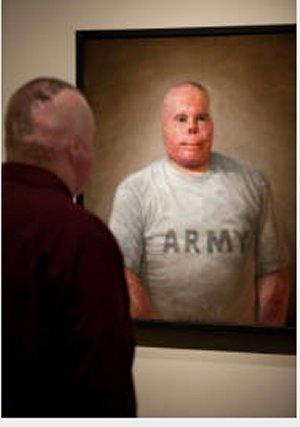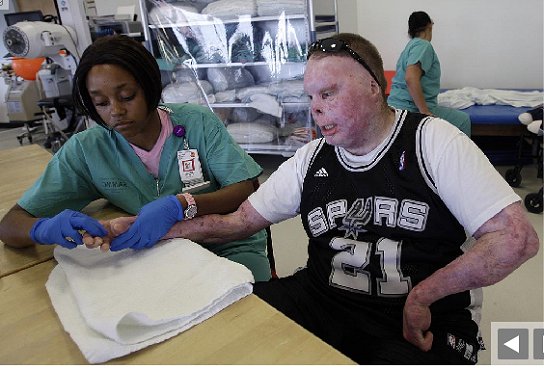
Army Sgt. Rich Yarosh stands near an oil-on-canvas portrait of himself Friday at the Smithsonian Institution’s National Portrait Gallery in Washington. Yarosh, 27, was left scarred and disfigured after an explosion while he was fighting in Iraq three years ago.
Portrait Does Justice to a Soldier’s Sacrifice
Arlene Coffman stared at the man in the painting. He had no ears, no nose, no eyebrows. Instead of smile lines by his eyes there was scar tissue. Tears welled in her eyes.
“It’s incredible. It’s hard to describe because it’s so moving,” said Coffman, 64, visiting here from Pebble Beach, Calif. “Most portraits bring emotions. This one is emotional in a different way.”
The face in Coffman’s gaze belongs to retired Army Sgt. Rich Yarosh. On Sept. 1, 2006, he was in the turret of a Bradley assault vehicle when it hit a roadside bomb in Baghdad. He and two other soldiers were engulfed in flames. One later died. Yarosh suffered burns on 60 percent of his body, lost part of his right leg and has limited use of what’s left of his hands.
Three years later, most of it spent in an Army hospital, and after 35 surgeries, his scarred countenance is now proudly featured at the Smithsonian National Portrait Gallery here. The painting is one of 49 finalists out of 3,300 entries in the museum’s second Outwin Boochever Portrait Competition. It will hang in the building for the next year with iconic images of presidents, scientists and celebrities.
“I didn’t want the depiction of his injury to overwhelm the depiction of his humanity,” said Matthew Mitchell, the Amherst, Mass., artist who painted Yarosh as part of a project called 100 Faces of War Experience. Despite the soldier’s obvious wounds, said Mitchell, “He’s a whole person.”
That’s something Tony Bass recognized. A portrait of the New York psychoanalyst stares across the second floor gallery toward Yarosh’s. Both men were among the first to view the paintings when the competition exhibit opened to the public Friday.
“There’s a sense of his having survived this horrendous trauma, a sense of his spirit coming though,” said Bass, 58. “The eyes and the stance – it’s an amazing picture of someone prevailing in the face of almost unbelievable tragedy.”
Museum curator Brandon Fortune, who organized the competition, said Miller’s portrait of Yarosh was “quite traditional” in its head-and-shoulders composition. “It has gravitas, that dignity that really gives it its power,” she said.
“He looks calm, like he’s dealing with it,” said Carmen Diaz, 66, of Alhambra, Calif. “He’s gone through the worst in life and yet he can smile. He can sit for this. He’s going on.”
Yarosh, now 27 and back home in Windsor, N.Y., didn’t accept his new look easily. He didn’t see his face until five months after the explosion – and then only by accident when he glimpsed himself in the reflection from a laptop computer screen.
“It took another six months to get used to it, especially to going out in public,” said Yarosh, who says he still scares little children sometimes. “I’m so used to it now. I still get looks but it doesn’t bother me.”
Several visitors wandering the gallery seemed drawn to his portrait. Many stopped to read Yarosh’s own words about his ordeal in Iraq: “That day started the same as every other day, but that day has never ended.”
The portrait is “beautiful but also alarming,” said Odile Schalit, 24, of New York. She wondered what it would be like to lose control over her own face, that most basic ingredient of identity. Then, gesturing around, she said, “After seeing this, so many of the other portraits seem so self-indulgent.”
Yarosh said he always wanted to sit for a portrait and is thrilled with the one Mitchell painted. He says the artist captured him “perfectly,” even though his lack of ears and a nose meant Mitchell had to paint “totally outside his box” to convey the soldier’s character.
“It’s more than just a portrait, more than just a painting,” Yarosh said. “It’s a story.”
Museum volunteer Heidi Whitesel, 67, of Gainesville, Va., said it was fitting that the soldier’s portrait hung among those of others who made a difference in history. Their achievements, she said, were often made possible by the sacrifice of those in the military.
“He’s transformed his personal tragedy into an inspiration for others,” she said. “It helps us to walk a little more in the shoes and have less fear and more respect.”
Some visitors chatted with Yarosh, who arrived before the museum opened. Others, though obviously moved by his likeness, seemed ill at ease when they realized he was nearby. Some glanced his way before moving to another gallery.
For a few, the portrait was political, a reminder of the horrors of war and the wrongness in particular of the one in Iraq. ( ASSHOLE COMMENT ~ Wild Thing )
“Every kid standing in line to go in the Army should look at this,” said Bill Meyer, 72, a retiree from Baja, Mexico. “It makes me very glad I chose not to go in the service.” ( ASSHOLE comment!!! ~ Wild Thing )
Kathryn Chase, 58, of Austin, said, “It’s wonderful someone is recording these tragic stories. I’m very opposed to that war but really respect the people sacrificing in it.”
Yarosh said he is “not a symbol of the war gone wrong” and remains “100 percent proud of my service” in Iraq. He hopes those who see his portrait come away with the same sense of pride.
A group of parents and their home-schooled children from Woodbridge, Va., who were on a field trip shared Yarosh’s pride and were also grateful for his sacrifice.
“This reminds me that our life is so easy compared to the soldiers fighting the war on a daily basis,” said Linene Kleppe, 36, whose husband is in the Air Force but whose job working with satellites has kept him off the battlefield. She asked her four children what they thought about the painting.
“I don’t really know,” said daughter Madigan, 8. Staring more intently, she added, “He looks like he’s been in a lot of battles.
“He’s just a guy with an Army shirt on,” said her brother McCoy, 6. “He’s happy. He’s not scary.”

Yarosh’s father holds a photo of the soldier taken before his injury in Iraq. On Sept. 1, 2006, the Bradley assault vehicle Yarosh was manning hit an explosive device. Engulfed in flames, he jumped from the top of the vehicle and rolled around on the ground to try and snuff out the fire. Yarosh eventually fell into a water-filled canal, where the flames were extinguished. He suffered burns on more than 60 percent of his body.

Yarosh’s body is covered in scar tissue, and he’s lost parts of his nose, ears and his right leg. His fingers are permanently bent and rigid.

Yarosh, here with President George W. Bush in 2007, said he is “not a symbol of the war gone wrong” and remains “100 percent proud of my service” in Iraq. He said he hopes those who see his portrait come away with the same sense of pride. (Source: AP)
.

Wild Thing’s comment………
This is a wonderful article minus the two scumbag assholes two comments. A story about an American Hero and I am honored to post this story!!! Thank you Army Sgt. Rich Yarosh for your service to our country, I can sit here in safety because of you sir.
 ….Thank you Mark for sending this to me.
….Thank you Mark for sending this to me.
Mark
3rd Mar.Div. 1st Battalion 9th Marine Regiment
1/9 Marines aka The Walking Dead
VN 66-67

Thanks WT. That is a great painting. And Sgt Yarosh’s struggles are nothing short of heroic. Words fail me.
Thank you WT, that was a great story and heartrending.
It is a great story his courage is awesome. Burns have got to be the hardest thing to come back from. They are not only fighting a mental and physical battle they are constantly fighting infections.
Great story, WT.